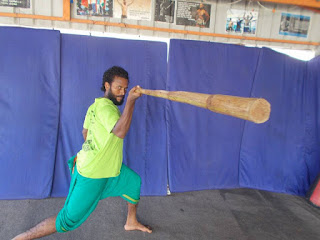Origins: Oral folklore traces silambam back several thousand years to the siddhar (enlightened sage) Agastya. While on his way to Vellimalai, Agastya discussed Hindu philosophy with an old man he met who said to be the god Murugan in disguise. The old man taught him of kundalini yoga and how to focus prana through the body's nadi (channels). Agastya practiced this method of meditation and eventually compiled three texts on palm leaves based on the god's teachings. One of these texts was the Kampu Sutra (Staff Classic) which was said to record advanced fighting theories in verse. These poems and the art they described were allegedly passed on to other siddha of the Agastmuniakhara (Agastya school) and eventually formed the basis of silambam, siddha medicine, and the southern style of kalaripayat.
References in the Silappadikkaram and other works of Sangam literature show that silambam has been practiced as far back as the 2nd century BC.
The bamboo staff - along with swords, pearls and armor - was in great demand with foreign traders, particularly those from Southeast Asia where silambam greatly influenced many fighting systems. The Indian community of the Malay Peninsula is known to have practiced silambam as far back as the period of Melaka's founding in the 15th century, and likely much earlier.
The soldiers of Kings Puli Thevarilitary training which favoured fire-arms over traditional weaponry. VeerapandiyaKattabomman and MaruthuPandiyar (1760–1799) relied mainly on their silambam prowess in their warfare against the British Army. Indian martial arts suffered a decline after the British colonists banned silambam.
They also introduced modern arts along with various other systems. During this time, silambam became more common in southeast asia than it’s native India.
References in the Silappadikkaram and other works of Sangam literature show that silambam has been practiced as far back as the 2nd century BC.
The bamboo staff - along with swords, pearls and armor - was in great demand with foreign traders, particularly those from Southeast Asia where silambam greatly influenced many fighting systems. The Indian community of the Malay Peninsula is known to have practiced silambam as far back as the period of Melaka's founding in the 15th century, and likely much earlier.
The soldiers of Kings Puli Thevarilitary training which favoured fire-arms over traditional weaponry. VeerapandiyaKattabomman and MaruthuPandiyar (1760–1799) relied mainly on their silambam prowess in their warfare against the British Army. Indian martial arts suffered a decline after the British colonists banned silambam.
They also introduced modern arts along with various other systems. During this time, silambam became more common in southeast asia than it’s native India.
Kattari : Silambam's main focus is on the bamboo staff. The length of the staff depends on the height of the practitioner. Ideally it should just touch the forehead about three fingers from the head, typically measuring around 1.68 metres (five and a half feet). Different lengths may be used depending on the situation. For instance, the sedikuchi or 3-foot stick can be easily concealed. Separate practice is needed for staffs of different lengths. Listed below are some of the weapons used in silambam.



Comments
Post a Comment